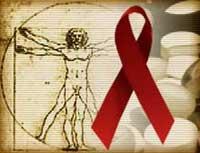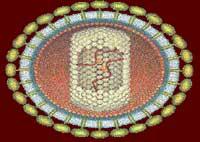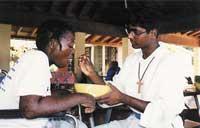20 years unable to flee AIDS
2001/06/05 Galarraga Aiestaran, Ana - Elhuyar Zientzia
That was ‘XX. First written imprint of what has been called the ‘epidemic of the twentieth century’. However, the virus had been polluting people around the world for years. In fact, Pasteur Institute researcher Luc Montaignier and American researcher Robert Gallo, separately, detected the AIDS virus by 1978.
The origin of AIDS is not entirely clear, but some believe that the African monkeys have produced a virus adapted to the human being. At first it was unknown, spread rapidly and has caused numerous deaths (22 million deaths worldwide and 40 million people suffer from viruses or disease).

Although laboratories and states around the world are investigating AIDS, no remedy has yet been achieved. However, much progress has been made, and despite the fact that previously the possession of a virus was a safe death, now the survival of the infected and the sick has increased considerably. At the same time, great work has been done in prevention, making every year there are fewer cases in different countries. Unfortunately, especially in the countries of southern Sahara, the situation is very serious and the epidemic continues to increase due to the low incidence of prevention campaigns and the difficulty of obtaining medicines.
On the other hand, research is being carried out in all areas: knowing the virus, knowing the mechanism of contamination, improving medicines, clarifying its relationship with genetics and, above all, obtaining the vaccine. And it seems that lately promising results are being obtained, since last week an effective vaccine was reported in a Belgian laboratory.
According to the GlaxoSmith Kline laboratory, this vaccine allowed infected monkeys over a year and a half in advance to remain healthy and before the end of the year to begin clinical trials in humans. The vaccine consists of two antigens and an auxiliary component. One of the antigens, GP120, has a good immune response to the virus and has long been known. But the other antigen (NefTat) is new and consists of two virus regulating proteins. The virus needs these two proteins to reproduce in the human body, so researchers believe they have found the key.
Undoubtedly, the good results of the vaccine in humans would be a huge achievement, but the rest of the lines of research have to go ahead and the struggle has to continue in all areas, because the victory is still far.
Additional information: http://www.cnn.com/SPECIALS/2001/aids/stories/diagnosis.then.now/index.html http://abcnews.go.com/sections/us/dailynews/aids_2001_intro.html

Gai honi buruzko eduki gehiago
Elhuyarrek garatutako teknologia






